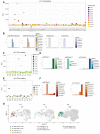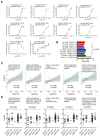Single-cell sequencing on CD8+ TILs revealed the nature of exhausted T cells recognizing neoantigen and cancer/testis antigen in non-small cell lung cancer
- PMID: 37544663
- PMCID: PMC10407349
- DOI: 10.1136/jitc-2023-007180
Single-cell sequencing on CD8+ TILs revealed the nature of exhausted T cells recognizing neoantigen and cancer/testis antigen in non-small cell lung cancer
Abstract
Background: CD8+tumor infiltrating lymphocytes (TILs) are often observed in non-small cell lung cancers (NSCLC). However, the characteristics of CD8+ TILs, especially T-cell populations specific for tumor antigens, remain poorly understood.
Methods: High throughput single-cell RNA sequencing and single-cell T-cell receptor (TCR) sequencing were performed on CD8+ TILs from three surgically-resected lung cancer specimens. Dimensional reduction for clustering was performed using Uniform Manifold Approximation and Projection. CD8+ TIL TCR specific for the cancer/testis antigen KK-LC-1 and for predicted neoantigens were investigated. Differentially-expressed gene analysis, Gene Set Enrichment Analysis (GSEA) and single sample GSEA was performed to characterize antigen-specific T cells.
Results: A total of 6998 CD8+ T cells was analyzed, divided into 10 clusters according to their gene expression profile. An exhausted T-cell (exhausted T (Tex)) cluster characterized by the expression of ENTPD1 (CD39), TOX, PDCD1 (PD1), HAVCR2 (TIM3) and other genes, and by T-cell oligoclonality, was identified. The Tex TCR repertoire (Tex-TCRs) contained nine different TCR clonotypes recognizing five tumor antigens including a KK-LC-1 antigen and four neoantigens. By re-clustering the tumor antigen-specific T cells (n=140), it could be seen that the individual T-cell clonotypes were present on cells at different stages of differentiation and functional states even within the same Tex cluster. Stimulating these T cells with predicted cognate peptide indicated that TCR signal strength and subsequent T-cell proliferation and cytokine production was variable but always higher for neoantigens than KK-LC-1.
Conclusions: Our approach focusing on T cells with an exhausted phenotype among CD8+ TILs may facilitate the identification of tumor antigens and clarify the nature of the antigen-specific T cells to specify the promising immunotherapeutic targets in patients with NSCLC.
Keywords: Antigens, Neoplasm; CD8-Positive T-Lymphocytes; Lymphocytes, Tumor-Infiltrating; Non-Small Cell Lung Cancer.
© Author(s) (or their employer(s)) 2023. Re-use permitted under CC BY-NC. No commercial re-use. See rights and permissions. Published by BMJ.
Conflict of interest statement
Competing interests: This study was partly funded by NEC Corporation.
Figures






References
Publication types
MeSH terms
Substances
LinkOut - more resources
Full Text Sources
Medical
Molecular Biology Databases
Research Materials
